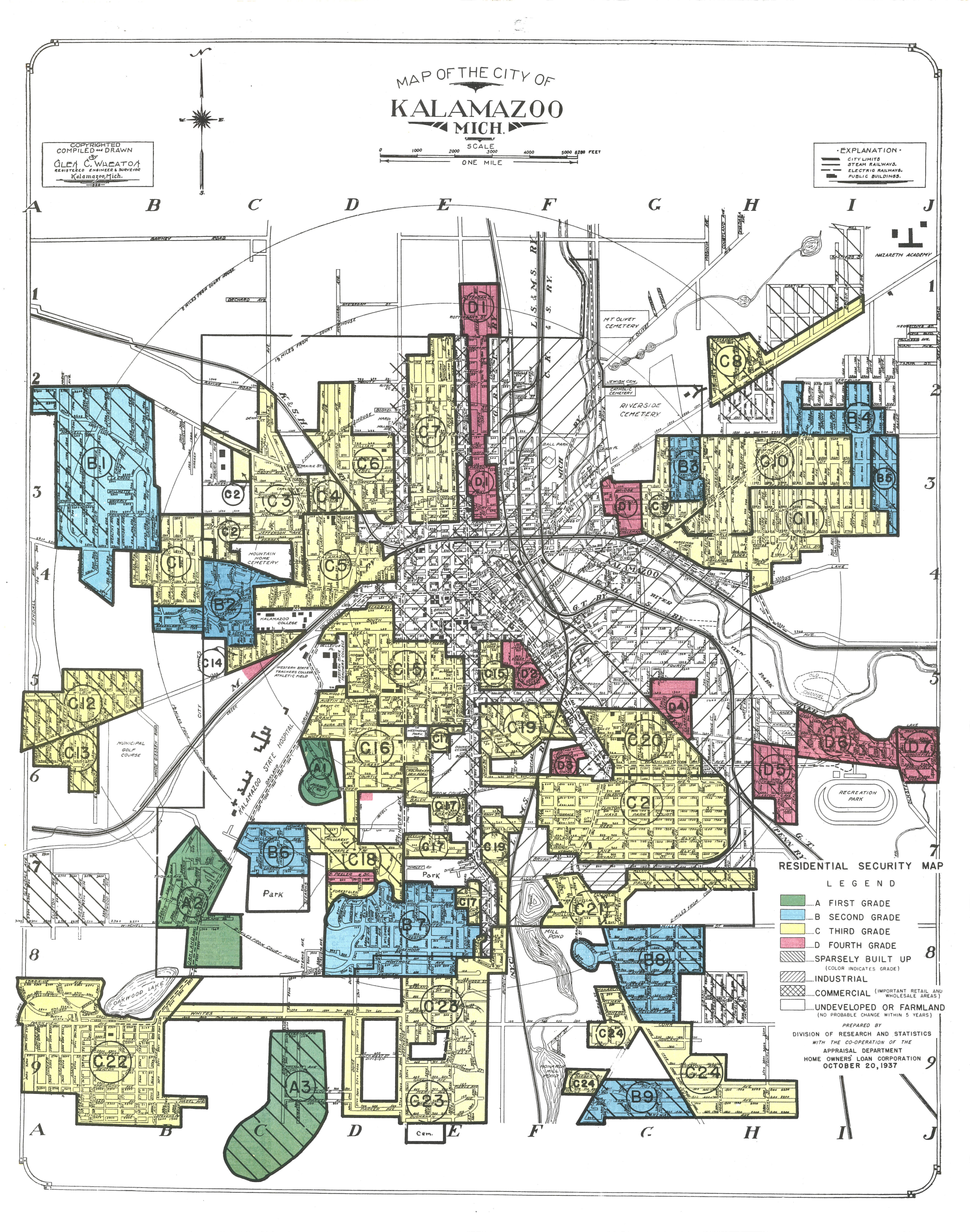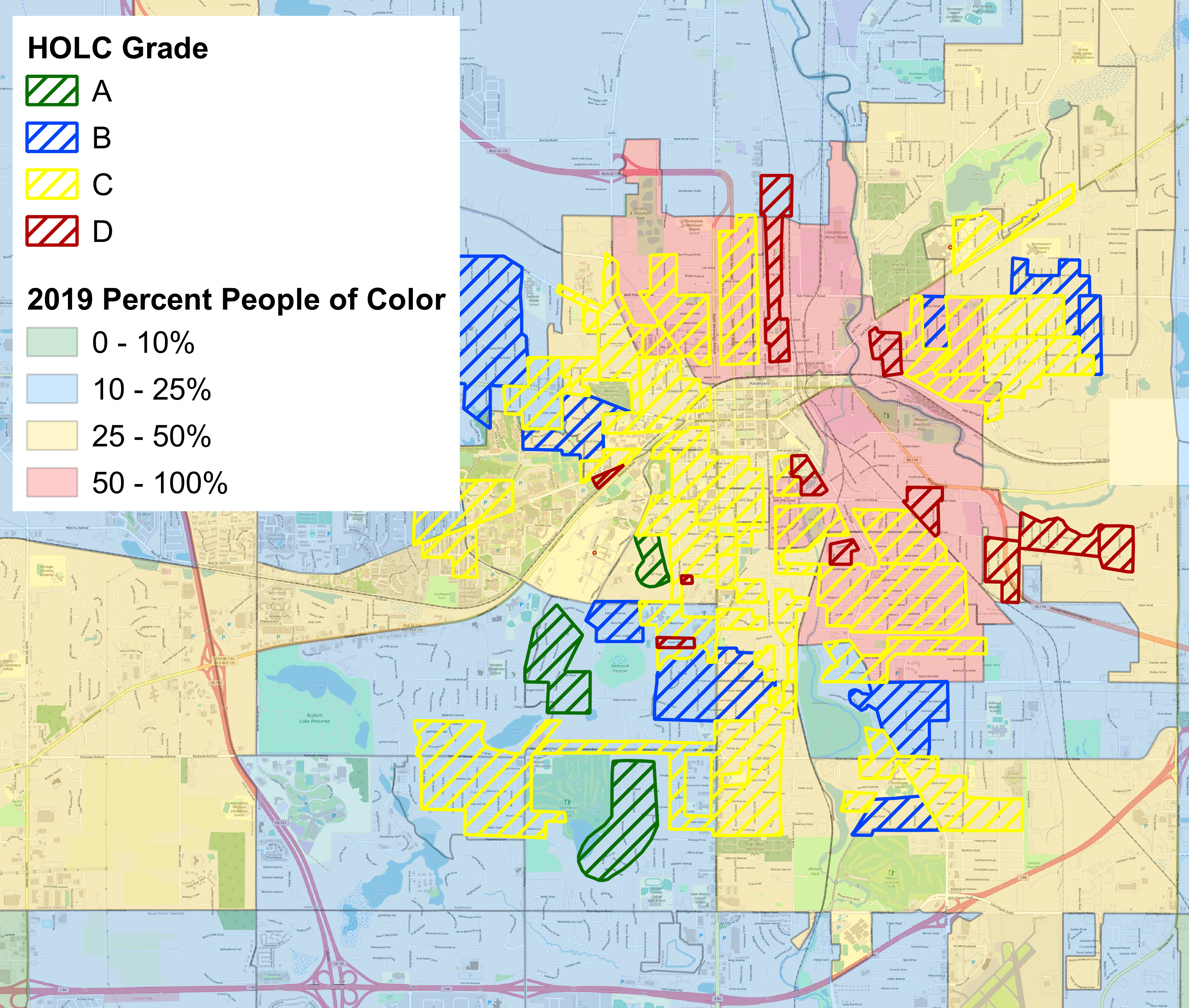Kalamazoo
The federal government redline mapped Kalamazoo on October 20, 1937. Consistent with the requirements of the government Underwriting Manual, the redline mapping specifically targeted residents of color, deeming their neighborhoods as “hazardous” to investment because they had residents of color or were even near residents of color. The original redlining map is shown below. While HOLC did not itself implement these redlining maps, it promoted these practices and showed private industry groups and the FHA how to reproduce these maps. We also have a map overlaying the original HOLC boundaries on present-day segregation, which starkly show the continued effects of these racist practices. The strong visual connection between original HOLC grades and present-day racial segregation, shows a legacy of redline mapping on present-day outcomes.

Kalamazoo Neighborhood Grading Justifications
The racist language and explanations below are quoted from the “Area Description Files” filled out by government appraisers. The language and justifications are coarse and offensive. Nonetheless, it is important to remember our past in all of its coarseness is offensiveness to fully understand the context that we confront today, especially when developing equitable housing policies.
Redlined neighborhoods
Government appraisers redlined Northside neighborhoods “Negro homes are all through the industrial area”
Government appraisers redlined a neighborhood between Kalamazoo College and Western Michigan University because “a few negro homes” were there.
Government appraisers redlined Eastside neighborhoods because they were poorly constructed and sliding into the Kalamazoo River.
In the south-central Kalamazoo (part of the Vine neighborhood), government appraisers redlined neighborhoods because “this area is negro.”
Yellow-graded neighborhoods
On the border of Northside and Eastwood Government, appraisers noted “people want to move out further.” “People” here refers to “White people.” Appraisers note the beneficial influence of the railroad tracks segregating Black and White families.
Government appraisers graded neighborhoods in the east Northside and West Douglas neighborhoods yellow because, despite good construction, “Hazardous. Alien area,” i.e. people with Italian and Dutch ancestry lived there.
Government appraisers graded neighborhoods adjacent to Western Michigan University and neighborhoods west of Kalamazoo College yellow because there were no racial restrictive covenants, deeds, or zoning.
In Edison neighborhoods, government appraisers noted segregated schools.
Blue-graded neighborhoods
In Eastwood, appraisers note the beneficial influence of the railroad tracks segregating Black and White residents. Neighborhoods are graded blue in Eastwood if they have “good” (segregated) schools or if there are held under a racially restrictive deeds or covenants.
West of Kalamazoo College (West Main Hill), appraisers noted the area had racially restrictive covenants and deeds and schools were racially segregated.
East of Westnedge and Southside Hill, the benefits of the railroad tracks segregating these White residents from Black residents is noted.
Green-graded neighborhoods
In Oakland/Winchell and in Vine, appraisers noted the segregated schools and the racially “highly restrictive” deeds and covenants.
The Legacy of Redlining in Kalamazoo
We overlay the historical HOLC “redlining” map on present-day demographic data to show the persistence and continued relevance of these racist policies on present-day segregation. We mirror the racist HOLC color gradation to help visualize the continued segregation, as a lasting impact of redlining.

Higher segregation is associated with lower incomes, lower educational attainment, more crime, worse health outcomes, and higher inequality. But segregation is not the only lasting impact of redlining in Michigan Cities, or in Kalamazoo. Researchers have shown that redlining also directly reduced many of these outcomes.
This research was conducted by Michigan State University Assistant Professor and Extension Specialist Craig Wesley Carpenter, Ph.D. (@DrCWCarpenter or cwcarp@msu.edu).



 Print
Print Email
Email